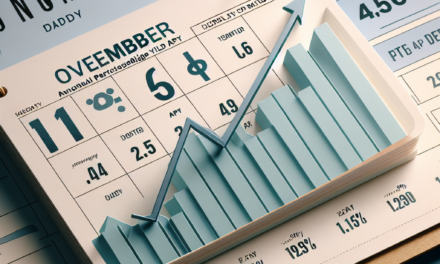“Maximize Your Returns: Top Picks for Up to 14% Dividend Yield!”
Introduction
Investors seeking robust income streams in the current market environment are turning their attention to dividend stocks, which offer the dual benefits of potential capital appreciation and regular income. Among the myriad of options available, analysts have spotlighted two standout dividend stocks that promise yields of up to 14%. These stocks not only provide attractive dividend returns but also come with strong fundamentals and growth prospects, making them appealing choices for income-focused investors. As market volatility persists, these high-yield dividend stocks present a compelling opportunity for those looking to bolster their portfolios with reliable income sources.
Understanding Dividend Stocks: A Path to High Yield
In the ever-evolving landscape of investment opportunities, dividend stocks have consistently attracted the attention of investors seeking a reliable income stream. These stocks, which distribute a portion of a company’s earnings to shareholders in the form of dividends, offer a compelling blend of income and potential capital appreciation. Recently, analysts have identified two dividend stocks that promise yields of up to 14%, making them particularly attractive to income-focused investors. Understanding the dynamics of these stocks and the factors contributing to their high yields is crucial for those considering adding them to their portfolios.
To begin with, dividend stocks are often favored by investors who prioritize steady income over high-risk, high-reward strategies. These stocks are typically issued by well-established companies with a history of stable earnings and a commitment to returning value to shareholders. The allure of dividend stocks lies in their ability to provide a consistent income stream, which can be particularly appealing in volatile market conditions. Moreover, reinvesting dividends can lead to significant compounding effects over time, enhancing the overall return on investment.
The two stocks recommended by analysts for their impressive yields are notable for their robust financial health and strategic positioning within their respective industries. The first stock, a leading player in the energy sector, benefits from a strong balance sheet and a diversified portfolio of assets. This company’s ability to generate substantial cash flow, even in challenging market environments, underpins its capacity to maintain and potentially increase its dividend payouts. Furthermore, the energy sector’s ongoing transition towards sustainable practices presents additional growth opportunities, which could further bolster the company’s financial performance and, by extension, its dividend yield.
The second stock, hailing from the telecommunications industry, is distinguished by its extensive network infrastructure and a loyal customer base. This company’s strategic investments in cutting-edge technology and expansion into emerging markets have positioned it well for future growth. As a result, it has consistently delivered strong financial results, enabling it to offer an attractive dividend yield. Additionally, the telecommunications sector’s essential role in the digital economy ensures a steady demand for its services, providing a stable revenue stream to support ongoing dividend payments.
While the high yields offered by these stocks are undoubtedly appealing, potential investors must also consider the associated risks. High dividend yields can sometimes signal underlying financial distress or unsustainable payout ratios. Therefore, conducting thorough due diligence is essential to ensure that the company’s fundamentals support its dividend policy. Investors should examine factors such as earnings stability, cash flow generation, and debt levels to assess the sustainability of the dividend yield.
In conclusion, dividend stocks remain a viable option for investors seeking a balance between income and growth. The two stocks recommended by analysts, with yields of up to 14%, exemplify the potential benefits of investing in companies with strong financial foundations and strategic growth prospects. However, as with any investment, it is crucial to weigh the potential rewards against the risks and to conduct comprehensive research before making investment decisions. By doing so, investors can better position themselves to capitalize on the opportunities presented by these high-yield dividend stocks while safeguarding their financial interests.
Top Analyst Picks: Dividend Stocks Offering Up to 14% Yield
In the ever-evolving landscape of investment opportunities, dividend stocks have consistently attracted investors seeking both income and growth. Recently, analysts have spotlighted two dividend stocks that promise yields of up to 14%, capturing the attention of those looking to enhance their portfolios with robust income streams. As the market continues to navigate economic uncertainties, these stocks offer a compelling proposition for investors prioritizing steady returns.
To begin with, the first stock under consideration is a well-established player in the energy sector. This company has demonstrated resilience in the face of fluctuating oil prices and regulatory challenges, maintaining a strong balance sheet and a commitment to returning value to shareholders. Its dividend yield, currently hovering around 14%, is a testament to its robust cash flow and disciplined capital management. Analysts highlight the company’s strategic investments in renewable energy projects, which not only diversify its revenue streams but also position it favorably in the transition towards sustainable energy solutions. This forward-thinking approach, coupled with its substantial dividend yield, makes it an attractive option for investors seeking both income and long-term growth potential.
Transitioning to the second stock, we find a leading entity in the telecommunications industry. Known for its expansive network and innovative service offerings, this company has consistently delivered strong financial performance. Its dividend yield, approaching 10%, is supported by a stable revenue base and a commitment to shareholder returns. Analysts emphasize the company’s strategic focus on expanding its 5G infrastructure, which is expected to drive future growth and enhance its competitive position. Moreover, its prudent financial management and cost optimization initiatives have bolstered its ability to sustain and potentially increase dividend payouts. For investors, this stock represents a blend of income stability and growth prospects, particularly in an industry poised for technological advancements.
In addition to their attractive yields, both stocks benefit from favorable market conditions and strategic initiatives that underpin their long-term viability. The energy sector, despite its inherent volatility, is witnessing a gradual recovery as global demand stabilizes and investment in cleaner energy sources gains momentum. Similarly, the telecommunications industry is on the cusp of a transformative phase, driven by the widespread adoption of 5G technology and increasing demand for connectivity solutions. These macroeconomic trends provide a supportive backdrop for the companies in question, enhancing their ability to deliver consistent returns to shareholders.
Furthermore, it is important to consider the broader implications of investing in high-yield dividend stocks. While the allure of substantial income is undeniable, investors must remain cognizant of the associated risks, such as potential dividend cuts or market volatility. Diversification, therefore, remains a key strategy in mitigating these risks and ensuring a balanced investment portfolio. By incorporating a mix of high-yield and growth-oriented stocks, investors can achieve a harmonious blend of income and capital appreciation.
In conclusion, the two dividend stocks recommended by analysts offer compelling opportunities for investors seeking substantial yields in a challenging market environment. Their strategic initiatives, coupled with favorable industry dynamics, position them as attractive options for those prioritizing income and growth. As always, investors are encouraged to conduct thorough due diligence and consider their individual risk tolerance before making investment decisions. With careful planning and a diversified approach, these dividend stocks can serve as valuable components of a well-rounded investment strategy.
How Analysts Identify High-Yield Dividend Stocks
In the ever-evolving landscape of investment opportunities, dividend stocks have consistently attracted investors seeking a reliable income stream. Analysts play a crucial role in identifying high-yield dividend stocks, offering insights that can guide investors toward potentially lucrative opportunities. Understanding the methodology behind these recommendations can provide valuable context for those looking to enhance their portfolios with dividend-paying equities.
To begin with, analysts typically start by examining a company’s financial health. This involves a thorough analysis of the company’s balance sheet, income statement, and cash flow statement. A strong balance sheet, characterized by low debt levels and ample cash reserves, often indicates a company’s ability to sustain dividend payments even during economic downturns. Furthermore, a consistent and growing revenue stream, coupled with stable or increasing profit margins, suggests that a company is well-positioned to continue rewarding its shareholders with dividends.
In addition to financial health, analysts also consider the company’s dividend history. A track record of consistent dividend payments, especially those that have been maintained or increased over time, is a positive indicator of a company’s commitment to returning value to its shareholders. Companies that have demonstrated resilience in maintaining their dividends during challenging economic periods are often viewed favorably by analysts. This historical perspective provides a level of confidence that the company will continue to prioritize dividend payments in the future.
Moreover, analysts pay close attention to the dividend yield, which is a key metric in evaluating dividend stocks. The dividend yield is calculated by dividing the annual dividend payment by the stock’s current price. A higher yield can be attractive to investors seeking income; however, it is essential to assess whether the yield is sustainable. An unusually high yield may be a red flag, indicating potential financial distress or an impending dividend cut. Therefore, analysts strive to balance the allure of high yields with the underlying stability of the company’s financials.
Another critical factor in identifying high-yield dividend stocks is the payout ratio, which measures the proportion of earnings paid out as dividends. A lower payout ratio suggests that a company retains a significant portion of its earnings for reinvestment or to cushion against future uncertainties, thereby enhancing the sustainability of its dividend payments. Conversely, a high payout ratio may indicate that a company is distributing most of its earnings as dividends, leaving little room for error in the event of an earnings decline.
Furthermore, analysts often consider the industry and market conditions in which a company operates. Certain sectors, such as utilities and consumer staples, are traditionally known for their stable cash flows and ability to pay dividends consistently. By contrast, industries that are more cyclical or subject to rapid technological changes may present higher risks to dividend sustainability. Analysts evaluate these external factors to gauge the potential impact on a company’s ability to maintain or grow its dividend payments.
In conclusion, the process of identifying high-yield dividend stocks involves a comprehensive analysis of a company’s financial health, dividend history, yield, payout ratio, and industry conditions. By synthesizing these elements, analysts can provide informed recommendations that help investors navigate the complex world of dividend investing. As investors seek to balance income generation with risk management, understanding the analytical framework behind these recommendations can be instrumental in making sound investment decisions.
The Benefits of Investing in Dividend Stocks for Income

Investing in dividend stocks has long been a favored strategy for those seeking a steady income stream, particularly in times of economic uncertainty. Dividend stocks are shares in companies that return a portion of their profits to shareholders in the form of regular payments, known as dividends. This approach not only provides investors with a reliable source of income but also offers the potential for capital appreciation. Recently, analysts have highlighted two dividend stocks that promise yields of up to 14%, making them particularly attractive to income-focused investors.
One of the primary benefits of investing in dividend stocks is the potential for consistent income. Unlike growth stocks, which reinvest profits to fuel expansion, dividend stocks distribute a portion of their earnings to shareholders. This can be especially appealing for retirees or those looking to supplement their income, as it provides a predictable cash flow. Moreover, companies that pay dividends often have a track record of stability and profitability, which can be reassuring for investors seeking to minimize risk.
In addition to providing income, dividend stocks can also offer a hedge against inflation. As the cost of living rises, the purchasing power of fixed-income investments, such as bonds, can erode. However, companies that consistently increase their dividend payouts can help offset this effect. By investing in stocks with a history of dividend growth, investors can potentially maintain or even increase their income in real terms over time. This makes dividend stocks an attractive option for those concerned about preserving their wealth in an inflationary environment.
Furthermore, dividend stocks can contribute to a diversified investment portfolio. By including dividend-paying stocks alongside other asset classes, investors can reduce overall portfolio volatility. This is because dividend stocks often belong to established companies with stable earnings, which can provide a buffer during market downturns. Additionally, the regular income from dividends can be reinvested to purchase more shares, compounding returns over time. This reinvestment strategy can enhance the long-term growth potential of a portfolio, making dividend stocks a valuable component of a well-rounded investment strategy.
Another advantage of dividend stocks is their potential for capital appreciation. While the primary focus for many dividend investors is income, the underlying stock can also increase in value. Companies that consistently pay and grow their dividends are often viewed favorably by the market, which can lead to stock price appreciation. This dual benefit of income and growth can enhance total returns, making dividend stocks an appealing choice for a wide range of investors.
However, it is important to consider the risks associated with dividend investing. Not all dividend stocks are created equal, and high yields can sometimes be a red flag. Companies offering unusually high dividends may be doing so because their stock price has fallen, potentially indicating underlying financial issues. Therefore, it is crucial for investors to conduct thorough research and consider factors such as payout ratios, earnings stability, and the company’s overall financial health before investing.
In conclusion, dividend stocks offer numerous benefits for income-seeking investors, including consistent income, inflation protection, portfolio diversification, and potential capital appreciation. With analysts recommending stocks with yields of up to 14%, now may be an opportune time for investors to explore the advantages of dividend investing. By carefully selecting high-quality dividend stocks, investors can enjoy a reliable income stream while also positioning themselves for long-term financial success.
Risks and Rewards: High-Yield Dividend Stocks Explained
Investing in high-yield dividend stocks can be an enticing prospect for many investors seeking to enhance their income streams. These stocks, often characterized by their ability to provide substantial dividend payouts relative to their share price, can offer yields as high as 14%. However, while the allure of such significant returns is undeniable, it is crucial to understand the inherent risks and rewards associated with these investments.
To begin with, high-yield dividend stocks are typically found in sectors that generate consistent cash flows, such as utilities, real estate investment trusts (REITs), and certain financial institutions. These companies often distribute a large portion of their earnings as dividends, making them attractive to income-focused investors. The primary reward of investing in these stocks is the potential for a steady income stream, which can be particularly appealing in a low-interest-rate environment where traditional fixed-income investments may offer limited returns.
However, the promise of high yields does not come without its share of risks. One of the most significant concerns is the sustainability of the dividend. Companies offering exceptionally high yields may be doing so because their stock prices have fallen, possibly due to underlying business challenges. This scenario can lead to a situation where the dividend payout is unsustainable, resulting in potential cuts or suspensions. Therefore, it is essential for investors to conduct thorough due diligence, examining the company’s financial health, earnings stability, and payout ratio to assess the likelihood of continued dividend payments.
Moreover, high-yield dividend stocks can be more sensitive to interest rate fluctuations. As interest rates rise, the relative attractiveness of dividend stocks may diminish, leading to potential declines in stock prices. This interest rate risk is particularly pertinent for sectors like utilities and REITs, which often rely on debt financing. Consequently, investors must consider the broader economic environment and interest rate trends when evaluating these stocks.
Despite these risks, analysts have identified two dividend stocks that stand out for their potential to deliver up to 14% yields. These stocks are backed by companies with robust business models and a track record of maintaining or growing their dividends. By focusing on firms with strong fundamentals, investors can mitigate some of the risks associated with high-yield dividend stocks. Additionally, diversification across different sectors and geographies can further reduce risk exposure, ensuring that an investor’s portfolio is not overly reliant on any single company or industry.
In conclusion, while high-yield dividend stocks can offer attractive income opportunities, they require careful consideration and analysis. Investors must weigh the potential rewards against the risks, taking into account factors such as dividend sustainability, interest rate sensitivity, and overall market conditions. By adopting a disciplined approach and focusing on companies with solid financial foundations, investors can enhance their chances of achieving favorable outcomes. Ultimately, the key to success in high-yield dividend investing lies in balancing the pursuit of income with prudent risk management, ensuring that the quest for yield does not compromise the long-term stability of one’s investment portfolio.
Comparing Dividend Stocks: Which Offers the Best Yield?
In the ever-evolving landscape of investment opportunities, dividend stocks have consistently attracted investors seeking a reliable income stream. Recently, analysts have spotlighted two dividend stocks that promise yields of up to 14%, sparking interest among both seasoned and novice investors. As we delve into the intricacies of these stocks, it is essential to understand the factors that contribute to their high yields and assess which might offer the best return on investment.
To begin with, dividend stocks are shares in companies that return a portion of their earnings to shareholders in the form of dividends. These stocks are particularly appealing to investors who prioritize income generation over capital appreciation. The allure of high-yield dividend stocks lies in their potential to provide substantial income, especially in a low-interest-rate environment. However, it is crucial to consider the sustainability of these dividends, as excessively high yields can sometimes signal underlying financial instability within a company.
The first stock under consideration is a well-established player in the energy sector. This company has consistently demonstrated robust financial performance, underpinned by its diversified portfolio of assets and strategic investments in renewable energy. Its dividend yield, currently hovering around 12%, is supported by strong cash flows and a commitment to returning value to shareholders. Analysts have noted that the company’s prudent management and focus on sustainable growth make it a compelling choice for income-focused investors. Moreover, its strategic initiatives aimed at reducing carbon emissions align with global trends towards cleaner energy, potentially enhancing its long-term viability.
In contrast, the second stock is a prominent entity in the telecommunications industry, offering a dividend yield of approximately 14%. This company has capitalized on the increasing demand for connectivity and digital services, which has been further accelerated by the global shift towards remote work and online communication. Its substantial yield is attributed to its dominant market position and ability to generate consistent revenue streams. However, analysts caution that the telecommunications sector is highly competitive, and the company’s ability to maintain its dividend yield may be challenged by technological advancements and regulatory changes.
When comparing these two dividend stocks, several factors must be considered. The energy company’s focus on sustainability and renewable energy investments positions it well for future growth, potentially offering a more stable dividend yield over the long term. On the other hand, the telecommunications company’s higher yield may appeal to investors seeking immediate income, but it carries a higher risk due to the competitive nature of the industry.
Furthermore, it is essential to evaluate the payout ratios of these companies, which indicate the proportion of earnings paid out as dividends. A lower payout ratio suggests that a company retains more earnings for reinvestment, potentially leading to future growth and dividend increases. Conversely, a higher payout ratio may indicate limited reinvestment opportunities, raising concerns about the sustainability of the dividend.
In conclusion, while both dividend stocks offer attractive yields, investors must weigh the potential risks and rewards associated with each. The energy company’s strategic focus on sustainability and renewable energy may provide a more secure long-term investment, whereas the telecommunications company’s higher yield could offer immediate income but with greater risk. Ultimately, the choice between these dividend stocks will depend on individual investment goals, risk tolerance, and market outlook. As always, thorough research and careful consideration are paramount when selecting dividend stocks to ensure a balanced and rewarding investment portfolio.
Strategies for Investing in Analyst-Recommended Dividend Stocks
Investing in dividend stocks has long been a favored strategy for those seeking a steady income stream, particularly in times of market volatility. Recently, analysts have spotlighted two dividend stocks that promise yields of up to 14%, capturing the attention of both seasoned investors and newcomers alike. Understanding the nuances of these recommendations can provide valuable insights into crafting a robust investment strategy.
To begin with, dividend stocks are shares in companies that return a portion of their earnings to shareholders in the form of dividends. This approach not only offers potential capital appreciation but also provides regular income, making it an attractive option for income-focused investors. The allure of high-yield dividend stocks lies in their ability to generate substantial returns, even when market conditions are less than favorable. However, it is crucial to approach these opportunities with a discerning eye, as high yields can sometimes signal underlying risks.
The first stock recommended by analysts is a well-established player in the energy sector. This company has consistently demonstrated its ability to generate strong cash flows, even amidst fluctuating oil prices. Its commitment to returning value to shareholders is evident in its impressive dividend yield, which currently stands at 14%. Such a high yield is indicative of the company’s robust financial health and its strategic focus on maintaining shareholder value. However, potential investors should consider the inherent volatility of the energy market and the company’s ability to sustain its dividend payouts in the long term.
Transitioning to the second recommendation, analysts have identified a leading real estate investment trust (REIT) that offers a yield of approximately 10%. REITs are known for their attractive dividend yields, as they are required by law to distribute a significant portion of their taxable income to shareholders. This particular REIT has a diversified portfolio of properties, which mitigates risk and enhances its ability to deliver consistent returns. The company’s strategic acquisitions and strong occupancy rates further bolster its financial stability, making it a compelling choice for dividend-seeking investors. Nevertheless, it is essential to consider the potential impact of economic downturns on the real estate market and the REIT’s capacity to adapt to changing conditions.
Incorporating these analyst-recommended stocks into an investment portfolio requires a balanced approach. Diversification remains a key principle, as it helps mitigate risks associated with individual stocks or sectors. By spreading investments across various industries and asset classes, investors can enhance their portfolio’s resilience against market fluctuations. Additionally, conducting thorough due diligence is paramount. This involves analyzing the company’s financial statements, understanding its business model, and assessing its growth prospects. Engaging with financial advisors or utilizing investment research tools can further aid in making informed decisions.
Moreover, investors should remain vigilant about the broader economic landscape. Interest rates, inflation, and geopolitical events can all influence the performance of dividend stocks. Staying informed about these factors can help investors anticipate potential challenges and adjust their strategies accordingly. It is also advisable to periodically review and rebalance the investment portfolio to ensure alignment with financial goals and risk tolerance.
In conclusion, while the prospect of high-yield dividend stocks is enticing, it is imperative to approach such investments with caution and strategic foresight. By leveraging analyst insights, conducting comprehensive research, and maintaining a diversified portfolio, investors can effectively navigate the complexities of the market and capitalize on the opportunities presented by these promising dividend stocks.
Q&A
1. **What is the main focus of the article?**
The article focuses on two dividend stocks recommended by analysts that offer yields of up to 14%.
2. **What is a dividend stock?**
A dividend stock is a share in a company that pays out a portion of its earnings to shareholders in the form of dividends.
3. **Why are high-yield dividend stocks attractive to investors?**
High-yield dividend stocks are attractive because they provide a steady income stream and can offer higher returns compared to other investments.
4. **What is the potential yield mentioned for these stocks?**
The potential yield mentioned for these stocks is up to 14%.
5. **What criteria do analysts use to recommend dividend stocks?**
Analysts typically consider factors such as the company’s financial health, dividend history, payout ratio, and growth potential.
6. **What are the risks associated with high-yield dividend stocks?**
Risks include potential dividend cuts, company financial instability, and market volatility.
7. **How can investors use this information?**
Investors can use this information to evaluate and potentially add high-yield dividend stocks to their portfolios for income generation.
Conclusion
Analysts have identified two dividend stocks that offer attractive yields of up to 14%, suggesting potential opportunities for income-focused investors. These stocks are likely appealing due to their high dividend payouts relative to their share prices, which can provide substantial income streams. However, investors should consider the sustainability of these dividends, the financial health of the companies, and the overall market conditions that could impact future performance. High yields often come with increased risk, so thorough due diligence is essential to ensure these investments align with individual risk tolerance and financial goals.





